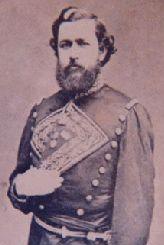The Cortina Troubles is the generic name for the First Cortina War from 1859 to 1860 and the Second Cortina War in 1861, in which paramilitary Mexican forces, led by the local leader Juan Nepomuceno Cortina, confronted elements of the United States Army, the Confederate Army, the Texas Rangers, and the local militias of Brownsville, Texas, and Matamoros, Tamaulipas, in the Rio Grande Valley area. According to author Robert Elman, Juan Cortina and his followers were the first "socially motivated border bandits," who conducted their raids more like a rebel army than that of a band of common criminals. At least 245 men were killed during the fighting between 1859 and 1861, most of whom were Mexicans.[2][3]
Trouble
First Cortina War
The First Cortina War began at Brownsville on July 13, 1859 when Cortina shot the town marshal, Robert Shears, in the arm for his brutalizing of Cortina's former employee, Tomás Cabrera. Tension increased between Cortina and the Brownsville authorities, and on September 28 he raided and occupied the town with a posse of between forty and eighty men. His enemies, however, had fled, and during the occupation of Brownsville, he issued a famous proclamation to reveal his intentions to both communities. "(...) There is no need of fear. Orderly people and honest citizens are inviolable to us in their persons and interests. Our object, as you have seen, has been to chastise the villainy of our enemies, which heretofore has gone unpunished. These have connived with each other, and form, so to speak, a perfidious inquisitorial lodge to persecute and rob us, without any cause, and for no other crime on our part than that of being of Mexican origin, considering us, doubtless, destitute of those gifts which they themselves do not possess. (...) Mexicans! Peace be with you! Good inhabitants of the State of Texas, look on them as brothers, and keep in mind that which the Holy Spirit saith: "Thou shalt not be the friend of the passionate man; nor join thyself to the madman, lest thou learn his mode of work and scandalize thy soul."
Cortina retained control over Brownsville until September 30, 1859, when he evacuated the town at the urging of influential residents of Matamoros. The following days, the townsfolk of Brownsville formed a twenty man group in order to fight Cortina, called the "Brownsville Tigers". In November, the Brownsville Tigers learned that Cortina was at his mother's ranch in the nearby town of Santa Rita, five miles west of Brownsville. They immediately launched an attack, only to be sent into retreat in disarray by Cortina's forces.
Later the same month, the Brownsville Tigers were joined by a group of Texas Rangers, and Cortina decided to attack them. The offensive was unsuccessful, and in December, a second group of rangers led by Captain John "Rip" Ford arrived, larger and better organized. Because of appeals from Brownsville anglo-occupying forces, the United States Army sent troops from San Antonio to the nearby Fort Brown, which had been abandoned a few years ago. The fort's new commander, Major Samuel Heintzelman, united and coordinated all armed groups to put an end to the Cortina threat. Cortina retreated up the Rio Grande, until on December 27, 1859 Heintzelman and Ford engaged him in the battle of Rio Grande City. Cortina's forces were decisively defeated, losing sixty men and all their equipment. Pursued and defeated by Ford again a few days later, Cortina retreated into the Burgos Mountains. The First Cortina War was mostly finished, and with increasing pressure from both the United States and Mexican Government to cease all hostile activities, Cortina remained away from the scene for more than a year. Perhaps the final engagement was the Battle of La Bolsa on February 4, 1860, in which John Salmon Ford and a group of rangers successfully defended a riverboat against an attack by Cortina's banditos.[4]
Second Cortina War
In May 1861, the much shorter Second Cortina War occurred. The American Civil War had just begun, and Cortina, who had aligned himself with the Federal Government of the United States, invaded Zapata County. He was defeated by Confederate Captain Santos Benavides at the battle of Carrizo and retreated back into Mexico, after losing eighteen men. Cortina would no longer conduct large scale military incursions within the territory of the United States, albeit accusations of promoting guerrilla actions against the richer Texan landowners in the area were numerous throughout the following years.




